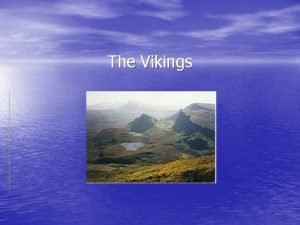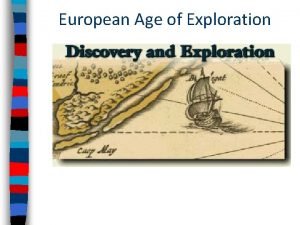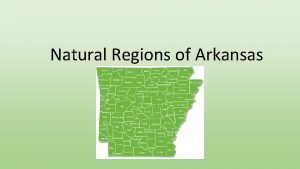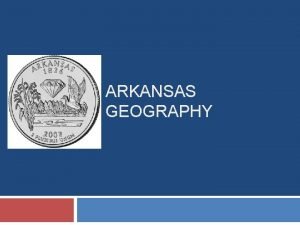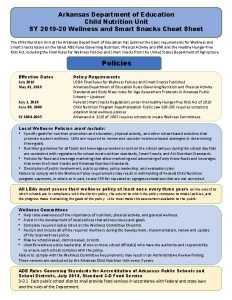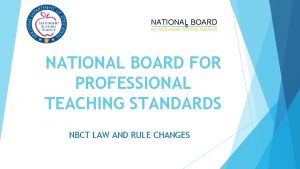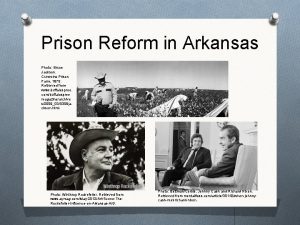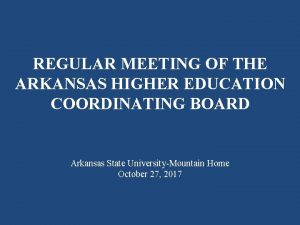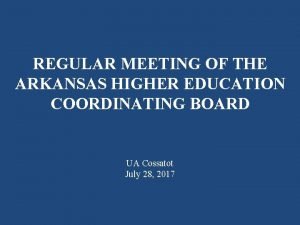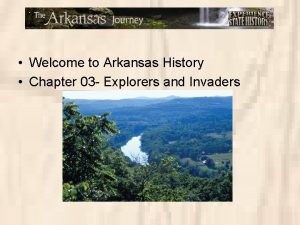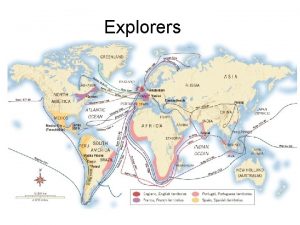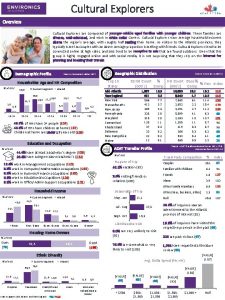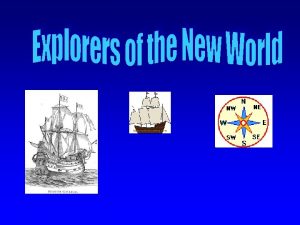Welcome to Arkansas History Chapter 03 Explorers and











































- Slides: 43

• Welcome to Arkansas History • Chapter 03 - Explorers and Invaders

Bell Work Agenda: Explorers & Invaders Homework: read pages 61 - 67 Objective: Students will examine the earliest explorers of Arkansas. 1. 2. Who fueled the fires of exploration? What Spanish explorer arrived about 50 years after Columbus? ostentatious - (adjective) overly showy, pretentious.

• Time Line – 1492 – 1780 • People to know… – Chief Angaska – John Cabot – Columbus – Hernando de Soto – Bernard de la Harpe – Jean Baptiste Filhiol - Henri de Tonti - Louis Joliet - La Salle - John Law - Marquette

• Places to Locate – Arkansas Post – Arkansas River – France – Great Britain – Mississippi River – Spain


• Europeans Invade Arkansas – Exploration changes both cultures – Religion – New land – Trade routes – Resources – Knowledge

• Columbus Fuels the Fire – Columbus told stories of great wealth when he returned to Europe – Other countries followed – England sent John Cabot to find a shorter route to Asia. – England claimed lands in the new world. • Spain, France, Holland, Italy, Great Britain, and Portugal all began to explore and claimed lands to establish trade.


• Hernando De Soto – Conquistadors means, “one who conquers. ” – Found large amounts of gold and silver in Mexico, when they landed 50 years after Columbus. – La Florida • 600 men wandered across the southeast • Treated natives badly – Stole food and supplies from the Indians • Killed and enslaved many Indians • Greatest fine – Mississippi River but no more great

• Invading Arkansas – Crossed the Mississippi River in the spring of 1541 – Found many native villages that they described as impressive. – De Soto hoped to supply his troops. – De Soto told the natives that he was “the son of the sun” and promised to bring rain. It did rain the next day. – The Indians did seem to see de Soto as a god.

• Problems Continue – Short on food and supplies – Lost much of their livestock – Many of his men died from disease or while fighting native groups. – The Tula Indians of western Arkansas were not intimidated by the Spanish and killed many using there long lances used for buffalo hunting.

• Problems Continue – After nearly a year, de Soto died from disease. – His body was wrapped and weighted down and dropped in the Mississippi River. • They didn’t want to let the Indians know that the god, de Soto was dead. – The remaining men fled down the river. – When they reached Mexico, around 300 men were left. – Spain did not return for many years.


Bell Work Agenda: Explorers & Invaders Homework: Reading Guide Ch 03 - Theme 02 Objective: Students will examine the earliest explorers of Arkansas. 1. Who crossed the Mississippi River in 1541 to enter Arkansas? 2. What happened to de Soto? Word of the Day adulation - (noun) extreme admiration.

• Changes for Native Americans – Disease was one of the most devastating changes to Native Americans. • Measles, tuberculosis, mumps, influenza, chicken pox and smallpox. • Their bodies had no immunities to these diseases. • These disease spread quickly and killed many Native Americans. – Killed and enslaved many Native Americans. – The lives enjoyed by many Native Americans were changed forever.


• Studying Tree Rings – Scientist have also found evidence in tree rings, that they may have experienced severe drought during this time.

• Legend of the Razorback – Have you ever wondered were we got the Razorbacks? – It is believed that domestic hogs escaped from the Spanish during a storm.

• French Explorers – With all the difficulties faced by de Soto, the Spanish did not return for nearly 100 years. – The French are going to take advantage of the Spanish absence. – King Louis XIV is going to push for more exploration. – 1673 - Catholic Priest Jacques Marquette and a fur trapper named Louis Joliet are going to travel down the Mississippi River to explore.

• French Explorers – Encountered the Quapaw Indians at the confluence of the White and Arkansas Rivers. • Confluence – were two rivers or streams come together. – Wanted to establish good relationship with the Indians, unlike the Spanish. – The French treated the Indians much better. • Two reasons – Religion – Trade

• French Explorers – Welcomed with • a ceremony • a feast • and an exchange of gifts. – Warned about the Spanish. • returned to Canada • believed the Mississippi River went to the Gulf of Mexico. • established good relationship with the Indians

• The Calumet Ceremony – The Calumet is a decorated pipe on a long stick (peace pipe). • • • Symbol of peace and friendship Used to negotiate with others The men would sit and smoke together. Dancing and feasting The Calumet is then given as a gift and to provide protection as they traveled.


• La Salle Explores Arkansas – Rene’-Robert Cavelier, Sieur de La Salle was born to a wealthy French family. – Was a teacher – Moved to New France (Canada) – Studied Indian culture. – Explored and traded with the Indians. – Searched for the mouth of the Mississippi River.

• La Salle Explores Arkansas – 1682 – traveled down the Mississippi River. – Visited the Quawpaw near the mouth of the Arkansas River. – Welcome with a Calumet Ceremony. – Placed a large wooden crossed and claimed the territory for France. – La Louisiane in honor of King Louis XIV – Found the Gulf of Mexico and claimed the land for France.


• A New French Colony – After returning to New France, La Salle asked for permission to start a new colony. • He was granted permission and supplies but failed to return to the mouth of the Mississippi when they were ship wrecked off the coast of Texas. • 1685 settlement established • Fort St. Louis • La Salle was killed by his own men on third attempt to find the Mississippi River. • Henri de Tonti – established the “Arkansas Post” near the mouth of the Arkansas River

• Life at Arkansas Post – Tonti hoped to established a trading post in Arkansas. – Quawpaw not interested in trapping beaver. – John Law attempted to establish the first post. • • (see Bursting the Mississippi Bubble) Many investors died before reaching the settlement. Financial problems in Europe crippled the new post. Early residents included soldiers, farmers, slaves, and trappers.

• Life at Arkansas Post – 1749 Official Census • • • 31 White Settlers 14 Slaves 29 Pigs 60 Cows 29 Bulls and Steers 3 Horses


• Moving the Post – Reasons why the post moved several time during its first 100 years: • seasonal flooding • fear of attack by British and Indians • mosquito infested conditions and disease – 1803 - Louisiana Purchase: Arkansas becomes part of the United State. – Today: national memorial and state park.


• Colonial Arkansas – Mercantilism – created to increase wealth and power through tight economic controls. – Colonies brought wealth into European countries. – Explorers searched for resources to increase the wealth of the mother countries. – Conflict developed between the European countries for control of new lands. – The French struggled to keep control of Arkansas.

• Trade Goods – Trade was difficult to establish in Arkansas. – Early trade included: • • Bear oil Buffalo meat Buffalo tallow (fat) Trappers traded beads, iron hatchets, pots, knives, guns, cloth, and blankets for Indian furs. • Deer Skin was the most common fur. • Indians hired to hunt and trade for Europeans.

• Farming – Arkansas Post never became a strong farming community. – Flooding and droughts caused havoc for settlers and farmers. – Quawpaw kept many settlers from starving. – Later improvements made life better but the post continued to need outside supples.

• Searching for Arkansas Treasure – Legends of gold, silver, and a large emerald rock spread in Europe. – Bernard de la Harpe was sent to find the treasure. – Emerald turned out to be sand stone. • La grande roche or “big rock. ” • La petit roche or “little rock. ” – La Harpe established a trading post at the site of a Quawpaw village near la petit roche.

• French and Indian War – 1754 – Start of French and Indian War between England France. • Conflict over territory in North America • “Seven Years War” • Quawpaw helped the French against the British and other Indians. • Prisoners of War kept at the Arkansas Post. • France lost the war and control of its territories in North America. • Spain gains control of the territory

Arkansas Post was first settled by the French in 1686.

• French Names – Many of our towns, rivers, streams, and places were named by the French. – Examples: • • Terre Noir Bayou De Roche Petit Jean Bayou Meto

• The American Revolution – Started not long after French and Indian War. – July 4, 1776 – 13 colonies declare their independence. – The British fought to keep their territory. – Allies in Arkansas • Supported by Spain – used Arkansas Post • British supporters attacked the post after the war was over (they hadn’t heard the news yet. ) • Spanish commander was upset with Chief Angaska, a Quawpaw, because he failed to warn the Spanish.

• Chief Angaska had been tricked some Chickasaw Indians, who said Americans were coming to visit the fort. • Chief Angaska and others tracked the attackers and those captured from the post. • Most of the captured were released and returned to the post.


• End of Slide Show
 Vikings: merchants and explorers
Vikings: merchants and explorers Chapter 9 attorney arkansas
Chapter 9 attorney arkansas Tudor explorers
Tudor explorers Explorers or boys messing about analysis
Explorers or boys messing about analysis Famous european explorers
Famous european explorers Tgcsa grading plaque
Tgcsa grading plaque Gold, glory and god
Gold, glory and god Jo vestey
Jo vestey European explorers webquest
European explorers webquest European explorers
European explorers Early explorers timeline
Early explorers timeline Explorers wordly wise
Explorers wordly wise Matching demand and supply
Matching demand and supply Tudor exploration
Tudor exploration Wise men three clever are we
Wise men three clever are we Arkansas career training institute
Arkansas career training institute What are the 6 regions of arkansas
What are the 6 regions of arkansas Arkansas mycopa
Arkansas mycopa Common core standards arkansas
Common core standards arkansas Six geographic regions of arkansas
Six geographic regions of arkansas Child nutrition unit arkansas
Child nutrition unit arkansas Arkansas environmental federation
Arkansas environmental federation Cottage law arkansas
Cottage law arkansas Arkansas development finance authority
Arkansas development finance authority Heather beech arkansas
Heather beech arkansas Pgp goals arkansas
Pgp goals arkansas Tess domains arkansas
Tess domains arkansas National board certification arkansas
National board certification arkansas Kzhe magnolia
Kzhe magnolia Alabama alaska arizona arkansas
Alabama alaska arizona arkansas Arkansas student gps
Arkansas student gps Child nutrition unit arkansas
Child nutrition unit arkansas Arkansas rapid naming screener
Arkansas rapid naming screener Cummins prison farm arkansas
Cummins prison farm arkansas Food safety management arkansas
Food safety management arkansas Arkansas act aspire
Arkansas act aspire [email protected]
[email protected] National district export council
National district export council Fish pulp
Fish pulp Rpz earl
Rpz earl United methodist foundation of arkansas
United methodist foundation of arkansas Tess rubric arkansas
Tess rubric arkansas Arkansas higher education coordinating board
Arkansas higher education coordinating board Arkansas higher education coordinating board
Arkansas higher education coordinating board
